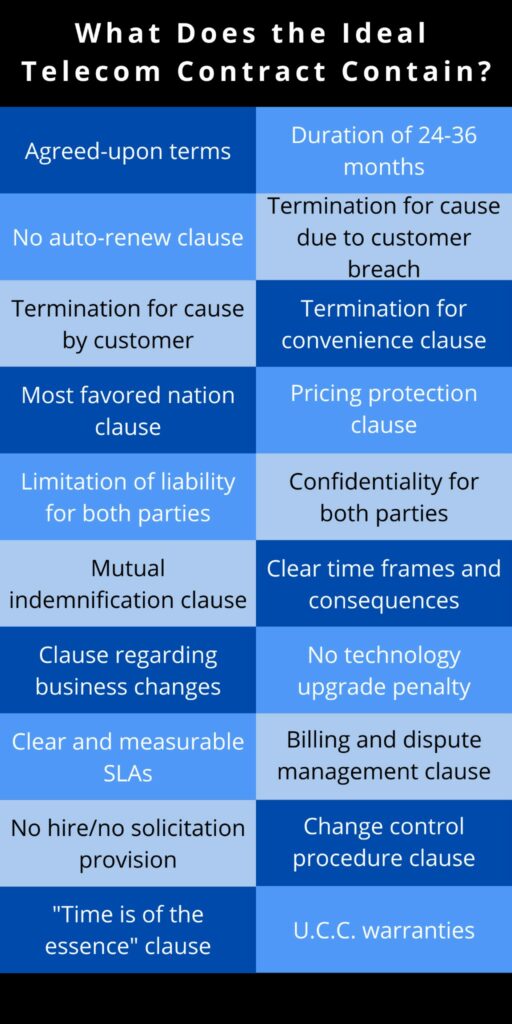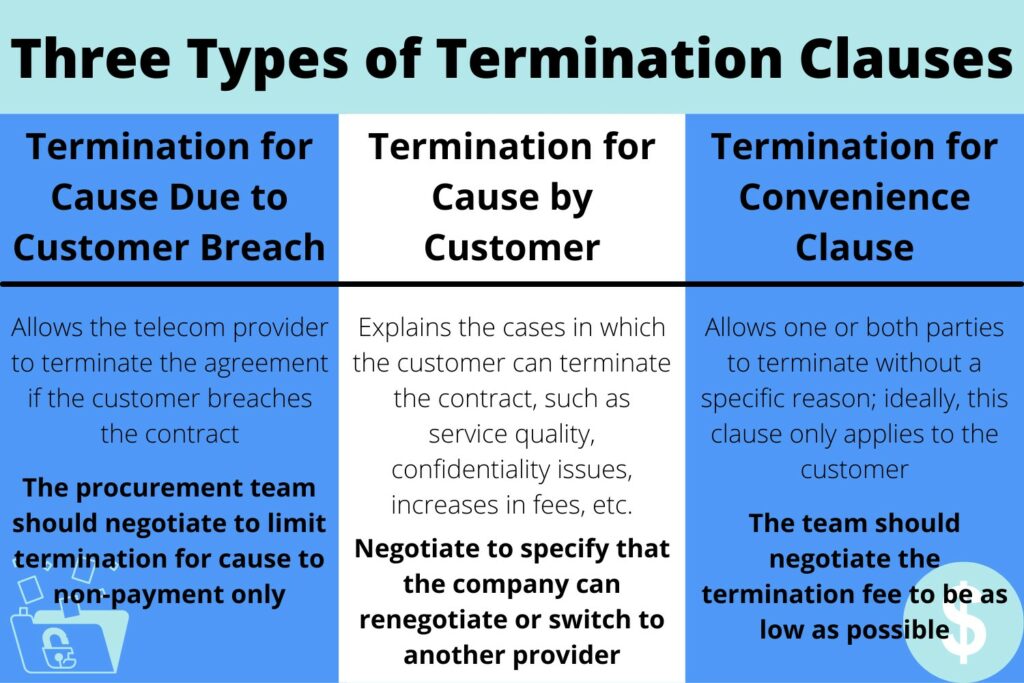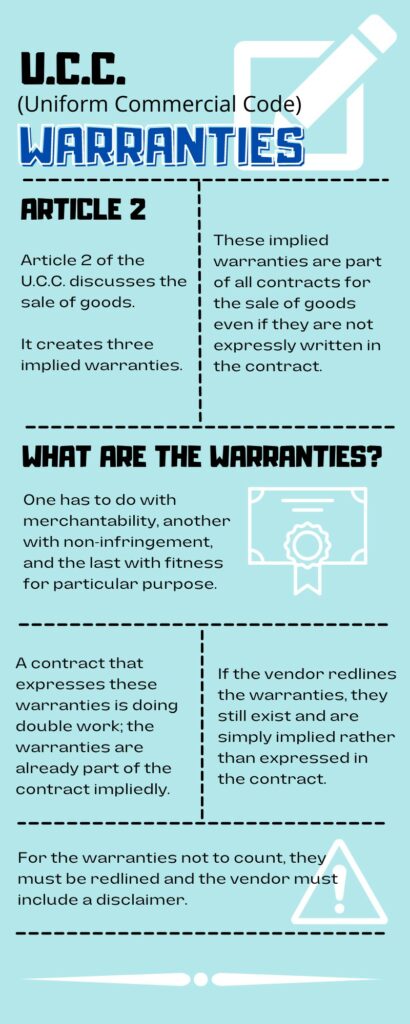Once negotiations have come to a close, it’s time to give the contract a final review before signing it and entering into an official business relationship with your chosen vendor. This article will cover must-have terms and clauses of telecom contracts and general tips regarding telecom contracts.

Disclaimer: The information found in this article is provided for educational purposes only and should not be construed as legal advice.
In search of expert insight into telecom negotiations and contracts? Technology Procurement Group’s experienced professionals are here to help you through the procurement process. To contact us, call 1-888-449-1580, email info@TPG-llc.com, or complete the form on our Contact Us page.
Table of Contents
20 Terms and Clauses of Telecom Contracts Need to Be Included
Below are the must-have terms and clauses of telecom contracts that need to include in your contract.

1. Agreed-Upon Terms
Your procurement team must be sure to check through every bit of the contract to confirm that all of the terms agreed on during negotiation are present. They also need to ensure that no last-minute commitments or clauses were added to the contract.
2. Duration of 24-36 Months
One of the important terms and clauses of telecom contracts is contact duration. Since technology and businesses can both grow and change so quickly, it’s essential to make sure the contract has a duration of no more than three years.

3. No Auto-Renew Clause
An auto-renew or “evergreen” clause can cause major issues down the line while also decreasing your company’s leverage.
In many cases, auto-renew clauses only allow for a very small window of time in which you can inform the vendor that you won’t be renewing the contract. Suppose this timeframe passes without your company notifying the vendor that it doesn’t wish to renew. In that case, you’re essentially forced into another contract with the same vendor, often with higher costs than the original contract.
4. Termination for Cause Due to Customer Breach

A termination for cause clause allows your telecom provider to terminate the agreement should you breach the contract. This clause lays out what will happen if and when you breach the agreement.
It’s in your company’s best interest to limit termination for cause to non-payment only. Negotiate realistic notice timelines that allow for plenty of time should your business need to react.
Another important aspect of this clause is your company’s cure rights. Cure rights are principles that allow your business to remedy its default by taking steps to cure it or to otherwise ensure compliance with the contract. Make sure that if there is a billing dispute, the telecom provider can’t terminate the agreement for non-payment. You should ask to limit remedies to the financial termination charge only.
5. Termination for Cause by Customer
This clause explains the cases in which you, as the customer, have the right to terminate the telecom contract.
It should cover situations in which your provider fails to meet the commitments within the agreement. These could range from service quality (SLA), failure to provide service in a reasonable manner, confidentiality issues, government regulatory changes that negatively impact your carrier, increases in regulatory fees and surcharges, or force majeure (unforeseeable circumstances) that prevent your carrier from delivering the agreed-upon services for an extended period of time.
This clause should specify that your company can either renegotiate the agreement or move its services to another competitive provider.
6. Termination for Convenience Clause

A termination for convenience clause allows one or both parties to terminate the contract without a specific reason for doing so. Defaulting or breaching the contract isn’t necessary to utilize a termination for convenience clause. In the case of terms and clauses of telecom contracts, the ideal setup is to have a termination for convenience clause that only applies to you and not the telecom provider.
Generally, it’s still necessary for the customer to pay for all work completed or products and services provided before the contract termination. In many cases, the customer also has to cover the costs of winding down vendor agreements and subcontracts affected by the contract termination.
For most terms and clauses of telecom contracts, termination for convenience clauses requires payment of a termination fee. This fee is typically based on a specified percentage of the remaining contract commitment, whether it’s a monthly or annual volume commitment. Carriers start with a 100% ask but usually settle for 25% to 50%. In later years of the contract term, it may be possible to reduce the percentage even more.
Be sure to negotiate so that past years’ spending overages count toward the remaining commitment. The final fee should be expressly agreed upon to be the provider’s sole remedy for the early termination of the agreement. Often, this is also the remedy used by the carrier if you breach the agreement.
7. Most Favored Nation Clause
A most favored nation clause is a type of contractual provision in which your provider agrees not to offer a better deal to another customer unless it offers similar terms to you (the original customer).
This clause is also called a most favored customer clause, a non-discrimination clause, or a prudent buyer clause.
There are several reasons why your company should negotiate for a most favored nation (MFN) clause. First, in industries such as telecommunications, where multiyear contracts are standard, and companies’ business models, products, and pricing are subject to change, customers often seek MFN clauses.
With this clause in place, you can feel confident that your provider’s pricing and service level will remain competitive since it’s at least as good as other customers’ pricing.

Customers with substantial volume commitments also have the leverage to request an MFN clause. The idea is that you’re saying, “I’ll be your biggest customer and spend more than anyone else, so I deserve your best price.” Some large enterprises also have the leverage to say, “If you don’t guarantee us your best prices with an MFN clause, we simply won’t buy from you.”
Situations in which you take a significant business risk and make a major purchase also provide the leverage needed to request an MFN clause. This is especially true if your risk is directly proportional to the provider’s gain.
For example, when a company implements a specific vendor’s telecom products and services, it may experience “lock-in” due to the high cost of switching to another vendor. This gives it the leverage to negotiate an MFN clause.
Finally, when your purchase of a product or service benefits your provider by increasing the network effect for that product or service, you can argue that your contribution to the provider’s success justifies an extra pricing benefit like an MFN clause. This may be the case in certain telecom contracts that utilize new technologies.
8. Pricing Protection Clause
A pricing protection clause states that the cost of telecom products and services is fixed for a specific period of time. This means that your vendor cannot change the price for the duration of that period.
9. Limitation of Liability for Both Parties
A good telecom contract protects both your vendor and your company with a limitation of liability.

10. Confidentiality for Both Parties
The confidentiality clause protects your vendor’s and your company’s intellectual property. Most confidentiality provisions require you to clearly identify information as “confidential” for it to be protected. This can be problematic because confidential information slips through all too often. Since every piece of information must be evaluated and identified, confidential information frequently fails to be marked as confidential and is susceptible to being shared.
All companies wish to minimize their own obligation of confidentiality while maximizing the vendor’s. The best way to do this is through a unilateral confidentiality provision, but you’ll rarely be able to get your vendor to agree to this. Still, some specific contract language can make the confidentiality agreement as favorable to your company as possible.
A comprehensive mutual confidentiality provision contains several elements:
- An acknowledgment that confidential information may be shared
- The meaning of confidential information
- “Carve-outs,” or what is not considered confidential information
- The obligation of confidentiality
- Cooperation to prevent the disclosure of confidential information
- Remedies for breach of obligation of confidentiality
Contract professionals are generally trained to pay special attention to the “carve-outs” that don’t apply to the obligation of confidentiality. Carve-outs often include:
- The vendor already had the information without an obligation of confidentiality
- The vendor independently developed the information
- The vendor obtained the information from another party that did not have an obligation of confidentiality
- The information was publicly available
Your vendor’s contract professionals aren’t as likely to closely examine the meaning of confidential information as defined in the contract. Usually, the definition of confidential information in a contract is information marked as confidential, or information that is disclosed and is shortly after declared to be confidential.

Your company’s contract template should state in the section that explains the meaning of confidential information that certain material is considered confidential, regardless of whether it is identified. After this definition is given, a list should be provided enumerating examples of this certain material, such as:
- Policyholder, customer, member, or supplier information
- Customer data
- Information regarding business plans and operations
- Information regarding administrative, financial, or marketing activities
- Pricing information
- Personnel information
- Product and service offerings
- Processes
- Any confidential information derived from information of a party
The key here is to use the phrase “including any” before going through the list. This phrase changes the list by making it infinite, meaning that everything of yours is now considered confidential unless it falls under one of the specified carve-outs.
Sometimes, the vendor will catch this and redline “including any” to say “from any,” making the list finite. However, the list should contain nearly all types of information that come from your company, maintaining the list as nearly unlimited.
11. Mutual Indemnification Clause
Mutual indemnification offers a sense of security to your vendor and yourself, as the company the vendor is working with. Once again, this clause should apply to both parties, not just the vendor. It means that both parties agree to compensate the other if damages arise from a contract breach for which the indemnifying party was responsible.
However, you should look out for ETFs, or Early Termination Fees, in this clause and negotiate to eliminate them.

Contracts don’t just lay out the rights and obligations of each party. They also allocate risk, and this is particularly true of the indemnification provision, which can shift liability from one party to the other.
As Stephen Guth, author of The Contract Negotiation Handbook, explains, “Indemnification permits a party who is legally responsible for a loss (the indemnitee) to shift the loss to the other party (the indemnitor).” It’s not surprising that indemnification provisions are frequently a point of contention between vendors and customers. The company, as the customer, wants the provision to be as broad as possible; the vendor wants the opposite.
Indemnification provisions are usually made up of three parts: the nature of the indemnity, the scope of the indemnity, and exclusion for contribution. The last section states that if your company contributed to the issue at hand, then the other party will not be on the hook for it.
Since this is usually the way these types of provisions are set up, your vendor will be looking for these three parts. Most of its focus will center on the list in the second section; when discussing the indemnity’s scope, an enumerated list follows, and this list explains what your vendor’s obligation of indemnification covers.
The key to writing an effective indemnification provision in the company’s contract template is to include two key terms: “any act” and “including, without limitation.” Here is how these phrases should be included in context:
“…arising out of or relating to any act, error or omission, or misconduct of Vendor, its officers, directors, agents, employees, and subcontractors, during the performance of this Agreement, including, without limitation, Claims arising out of or relating to…” (Source: The Contract Negotiation Handbook)
The indemnification provision is extremely broad and favorable when written in this way. If your vendor doesn’t redline any part of this provision, it will indemnify your company against any act under the contract.
Technology Procurement Group can assist you throughout each step of the procurement process. Fill out the form at the bottom of the page for more information. You can also get in touch by calling us at 1-888-449-1580 or emailing us at info@TPG-llc.com.
12. Clear Time Frames and Consequences

Indemnification should clearly stipulate the time frames and consequences for delivery, payment, and any other parts of the agreement. This is the best way to eliminate disputes regarding penalties and payment terms.
13. Clause Regarding Business Changes
There should be a clause covering different types of business change that may take place, such as a downturn in your business, a merger, acquisition, divestiture, joint venture, internal reorganization, outsourcing (in which your business needs a right to move the contract to an outsourcing company), or loss of key customers (such as the loss of a federal government contract). This clause should offer protection in the case that your business’s model changes.

14. No Technology Upgrade Penalty
Another necessary clause is one that specifies there is no penalty for technology upgrades. Unfortunately, many vendors will penalize the companies they work with if they wish to upgrade to new technology, even if that technology is more economical and beneficial.
15. Clear and Measurable SLAs
The Service Level Agreements must be clear and measurable so that both parties understand the level of service required and any penalties and remedies if the service does not meet the specified level.

16. Billing and Dispute Management Clause
A billing and dispute management clause dictates how disputes between your vendor and your company will be managed. This clause should protect your company and provide it with the ability to receive refunds and credits as far back as allowed by the law.
In many cases, vendors will specify a very short window in which your company can dispute a charge. After that window closes, undue charges no longer qualify as errors or billing disputes. With a billing and dispute management clause, you can avoid this situation.
17. No Hire/No Solicitation Provision

Most contracts between a company and a vendor have a mutual “No Hire” or “No Solicitation” provision that prevents each party from hiring the other party’s employees. Generally, the non-solicitation period covers the performance period plus six months, although the timeframe can vary.
There is usually a provision that states an exception or standard carve-out. If one party’s employees independently respond to the other party’s hiring ads, that does not breach the No Solicitation provision. (However, neither party is permitted to induce the other’s employees to respond to a job advertisement.)
A third provision details the remedy in the form of liquidated damages should one party breach the initial No Solicitation provision. This provision acts as a deterrent and a penalty for both parties; it encourages them not to solicit the other’s employees and forces them to pay a penalty if they still choose to breach the agreement.
Vendors’ contract lawyers always look for the No Hire or No Solicitation provision in contracts since, in most cases, the customer is the one that wants to poach the vendor’s employees. They’ll scan the agreement to ensure that there is a No Hire provision and check for the penalty for breach and the standard carve-out. Generally, they won’t look at the actual amount of liquidated damages specified as the penalty, and that’s where your company’s procurement team can be strategic.
The key here is to specify that the amount of liquidated damages to serve as the penalty should be 20%. This is the same amount that most recruiting firms charge for their services.
By including this amount, if your company does hire one of the vendor’s employees, you’ll pay no more for the penalty than you would’ve if you had been working with a recruiting firm. Something to note, though, is that since this provision is mutual, your vendor can also hire your company’s employees with only a 20% penalty.
18. Change Control Procedure Clause
Termination clauses are sometimes the most powerful form of leverage and influence your company can have in business relationships with a vendor.
As Stephen Guth explains, “Your leverage decreases directly in proportion to any dilution of your right to terminate the business relationship.” Therefore, the ultimate and most powerful form of leverage is the right to immediate termination.
This is why it’s key to include an immediate termination clause in your company’s contract template. Still, most vendors will redline this clause and at least require 30 to 90 days of advance written notice before termination.
But there is a way for your company to secure its right to immediate termination, and it lies within the Change Control Procedure clause, which is a pretty standard one that your vendor will likely breeze past.
Under Customer Changes in Scope, here are two imperative sentences to include: “Customer shall have the right, in its sole discretion, and for any reason whatsoever, to decrease the scope of the Services. In such a case, the fee for the applicable Exhibit A will be reduced by an amount consistent with the decrease in scope.” (Source: The Contract Negotiation Handbook)
Your vendor isn’t likely to pay much attention to this clause because it doesn’t often think of changes in the scope of services as a reduction to zero. But with this clause in place, you, as the customer, have the right to reduce the scope of services to zero, which is a form of immediate termination.
19. “Time Is of the Essence” Clause

As a general rule, all lawyers know that the phrase “time is of the essence” is terrible for them. This is because it gives the customer the power to cancel the contract if the vendor is even a second late regarding any of its responsibilities. That’s far too much customer leverage for the vendor to be comfortable with.
Your company’s contract template should include the phrase “time is of the essence” within the termination provision. However, it’s critical that your company does not have the standard “headings” provision, which states that the contract’s headings have no contractual force and are only meant to be used for clarification and convenience. This is extremely important because the vast majority of all contracts have this “headings” provision.
Because your vendor is so used to all contracts having the “headings” provision, it will most likely only glance at the headings within the contract template and focus its concentration on the body of the provisions.
When your vendor sees the phrase “time is of the essence” within the body of the contract template’s termination clause, it will redline it. It likely won’t notice that the phrase is also in the heading of the termination clause.
Your procurement team should push against the redlining of the phrase found in the body of the provision–why can’t your vendor agree and commit to staying on schedule? Your team will likely have to give up on this particular redline, but you’ll still have “time is of the essence” in the heading of the termination provision.
Vendors will generally skip over redlining the heading because nearly all of their contracts have the aforementioned headings clause. As a result, your company’s procurement team has managed to get its “time is of the essence” provision into the contract, despite your vendor redlining it from the body of the provision. This strategy doesn’t work 100% of the time, but it’s effective in most cases.
The UCC, or Uniform Commercial Code, creates uniformity in all states except Louisiana regarding commerce. Specifically, Article 2 of the UCC discusses the sale of goods and has to do with the offer of goods for sale, acceptance, sale terms, and warranties. By state law, the warranties laid out by the UCC are included in every sale of goods except in the situation that the warranties are expressly disclaimed in the contract.
20. UCC Warranties

What comes to mind when the word “warranty” is used is typically an express warranty. Express warranties are express promises about the quality and features of the product or service. An express warranty might look like a 50,000-mile car warranty or a one-year refrigerator warranty.
But the UCC created a second type of warranty: an implied warranty. This means that the warranty is part of a contract, even if it isn’t expressly written in the contract.
The UCC essentially creates three implied warranties. One has to do with merchantability, another with non-infringement, and the last with fitness for a particular purpose. If your vendor does not want these warranties to apply to the contract, failing to include them is not enough. Your vendor must expressly disclaim the warranties if it does not want to provide them.
To summarize, the Uniform Commercial Code created implied warranties of non-infringement, merchantability, and fitness for particular purposes that are included in all contracts for the sale of goods. The only way to eliminate these implied warranties is to have an express disclaimer.
If a contract includes or “expresses” these warranties, then it is doing double work. It’s not necessary to write out these warranties because they are implied.

If your contract expressly contains these warranties, but your vendor redlines them and adds the disclaimer, then the implied warranties are deleted. However, the warranties still existed after being redlined up until the point that your vendor wrote the disclaimer.
What if your vendor redlines the expressly-written warranties but fails to include the disclaimer? In that case, the warranties still apply.
Let’s say that your procurement team sends your company’s contract template to your vendor with the warranties expressed, and your vendor redlines them.
The majority of the time, the vendor completely forgets to add the required disclaimer–which means that the warranties still apply to the contract. These implied warranties mean just as much as if they were written out and expressed within the contract.
However, if your vendor redlines the warranties but doesn’t add the disclaimer, it’s vital for your procurement team to fight against it, asking why your vendor won’t warranty what it is selling, and so on. This could even be an opportunity to trade the warranty deletions for another desired concession. Still, even though your procurement team is pushing back against the deletion of the warranties, it knows that your company still has the protection of the implied warranties.
This tactic is essentially an illusion. The contract template draws your vendor’s attention to the express written warranties, which leads your vendor to redline the warranties and forget that it must add a disclaimer for its redlines to mean anything. This strategy is highly effective and works approximately nine times out of ten.
Telecommunications Contract Tips
Here are a few final tips for you as your company prepares to sign a telecommunications contract.
1. Don’t Sign Without Reading it Thoroughly
Even if negotiations went exceptionally smoothly, it’s one of the common telecom procurement mistakes to sign the contract without going through it line by line. It’s crucial to read through the main agreement, the terms and conditions, the SLAs, and any other fine print.

Unfortunately, vendors will often hide adverse terms in the service guide and terms and conditions, where they aren’t as likely to be discovered and renegotiated. Therefore, your team must go through the contract with a fine-toothed comb before officially signing it.
2. Regulatory Issues to Consider
While looking over the terms and clauses of telecom contracts, there are a few regulatory issues to keep in mind.
- Order of Precedence – Make sure that the master contract itself takes precedence over website terms and conditions, service attachments, and tariffs at the state, federal, and foreign levels. Rather than incorporating terms and conditions “by reference,” it’s best to directly include them in the agreement.
- Federal Detariffing Push – Currently, the FCC is actively working to remove the burdens of tariffs, or regulations imposed on the telecom industry, because there’s plenty of competition in most areas of the marketplace. As this trend continues, tariffs won’t be relied on as frequently by service providers, and, as a result, pricing will become easier to compare. The regulation’s impact on contract language will also be simplified.
- Cancellation in Response to Adverse Conditions – Negotiate for the ability to partially or fully cancel if regulators impose adverse conditions that negatively impact your company.
- Cost Risk from Regulatory Charges – The majority of telecom carriers pass along USF charges, adding considerable costs to your company’s telecom bill. These USF charges can add as much as 25% to 33% to your company’s invoice monthly, and they change quarterly. Therefore, they’re extremely difficult to budget for; it’s impossible to predict how the FCC will modify them. The best possible move for your company is to ensure that your vendor is not marking up these charges at all, and that if your vendor is waiving or reducing them for another customer, it waives or reduces them for you as well. This can be accomplished using a Most Favored Nation clause.
3. Strategies for Obtaining Signatures
Obtaining “wet” signatures from all parties involved in the contract is often a logistical nightmare. However, there are many ways to get signatures more quickly and easily. Counterparts are one way of going about this.
Here’s how it works: Each party signs the contract at its location and then sends its signed copy to all of the other parties involved. The other parties do the same, signing an agreement at their locations and sending it to all other parties. As a result, each party receives a signed contract from all other parties.
In the end, every party has multiple individually signed contracts that count as one contract signed by all involved. Still, using counterparts can be almost as much of a pain as getting traditional wet signatures.
Another option is to use a fax machine to fax signatures to the other parties. Including the following sentence within the contract allows for this: “The parties agree that a facsimile signature may substitute for and have the same legal effect as the original signature.”

Of course, even more straightforward than utilizing counterparts or faxed signatures is to get electronic signatures. Automating the process makes it quicker and more accessible and eliminates the struggles associated with geographical dispersion.
4. Check the Payment Provisions
Before officially signing the contract, it’s crucial to double-check the payment provisions. Ensure that the agreement provides a reasonable grace period before payment is due and that the amount of interest applied to late payments is acceptable. Ideally, the payment date should be tied to the invoice’s date or a verifiable online billing date. Your organization should also have the ability to dispute charges.

5. Ensure Contract Matches Negotiations 100%
As mentioned in the terms and clauses of telecom contracts must-haves earlier in this article, the contract must contain all of the previously agreed-upon terms. The contract needs to match the negotiations 100%, which is why it’s very important to keep an ongoing record of everything discussed and decided throughout the RFP and negotiation process.
Rather than relying on verbal promises, getting a written record is always necessary. Being able to turn back to the written record to verify previous negotiations is much more effective than attempting to hold your vendor to the spoken words of one of its salespeople.
6. Have a Lawyer Read Over the Contract
It’s crucial to have either in-house or hired legal counsel as a part of your procurement team. One reason for this is to have them read over the contract before signing it. Sometimes, laymen can miss certain phrases and overlook clauses that may adversely affect their business while benefiting the vendor.
Lawyers have plenty of knowledge regarding what to look for and how a contract should be structured, so having one read through the terms and clauses of telecom contracts can be massively beneficial.

7. Notify Vendors that Weren’t Chosen
Rather than leaving the other vendors hanging, it’s better to communicate with them and explain to the contacts provided why they were not chosen. Providing feedback allows these vendors to improve their offerings and approaches in the future, and it’s much more polite and professional than abruptly breaking off contact.
In addition, clear and direct communication helps maintain a positive relationship between your company and the vendors that weren’t chosen, which is important in case you want to work with these vendors in the future.
A tip for doing this effectively is to send out individual personalized emails to each of the vendors. Sending out a bulk email comes across as inconsiderate, while personalized emails show the vendors that your organization took the time to truly consider their bids. Within the emails, using specific names of vendor employees that your organization communicated with during the process also shows that the vendor’s bid was taken seriously.
While using a template for these emails is acceptable, adding personalized touches only takes a few minutes and is worth the extra time.

Rather than simply sending a generic email that says your company has gone in a different direction, it’s better to provide as many details as possible, along with genuine thanks for the time and effort the vendor put in. It’s also great to explain to the vendors why they weren’t chosen, although maintaining privacy and confidentiality is crucial. Remember that the vendor took hours or even weeks to develop a proposal and communicate with your business, and it’s imperative that its hard work is appreciated for there to be any hope of potentially working together on a different project in the future.
8. Write a Deliverable Document
After signing the contract, your procurement team should write a deliverable document for the executives and RFP team. This document should provide a summary of the results of the executed contract. Important components to include are benchmarks, savings projections, timelines, and milestones.
Technology Procurement Group Can Help

The telecom procurement process can be quite the challenge, but it doesn’t have to be. Working with Technology Procurement Group’s industry professionals streamlines and optimizes the process to help you achieve your business objectives and earn cost savings.
Not only do we offer telecom procurement strategy consulting and IT procurement services, but we also provide telecom and wireless expense management, RFP management, wireless expense reduction, and telecom contract negotiation.
Interested in getting more information? Call us at 1-888-449-1580, email us at info@TPG-llc.com, or fill out the simple form on our Contact Us page. We look forward to hearing from you!




